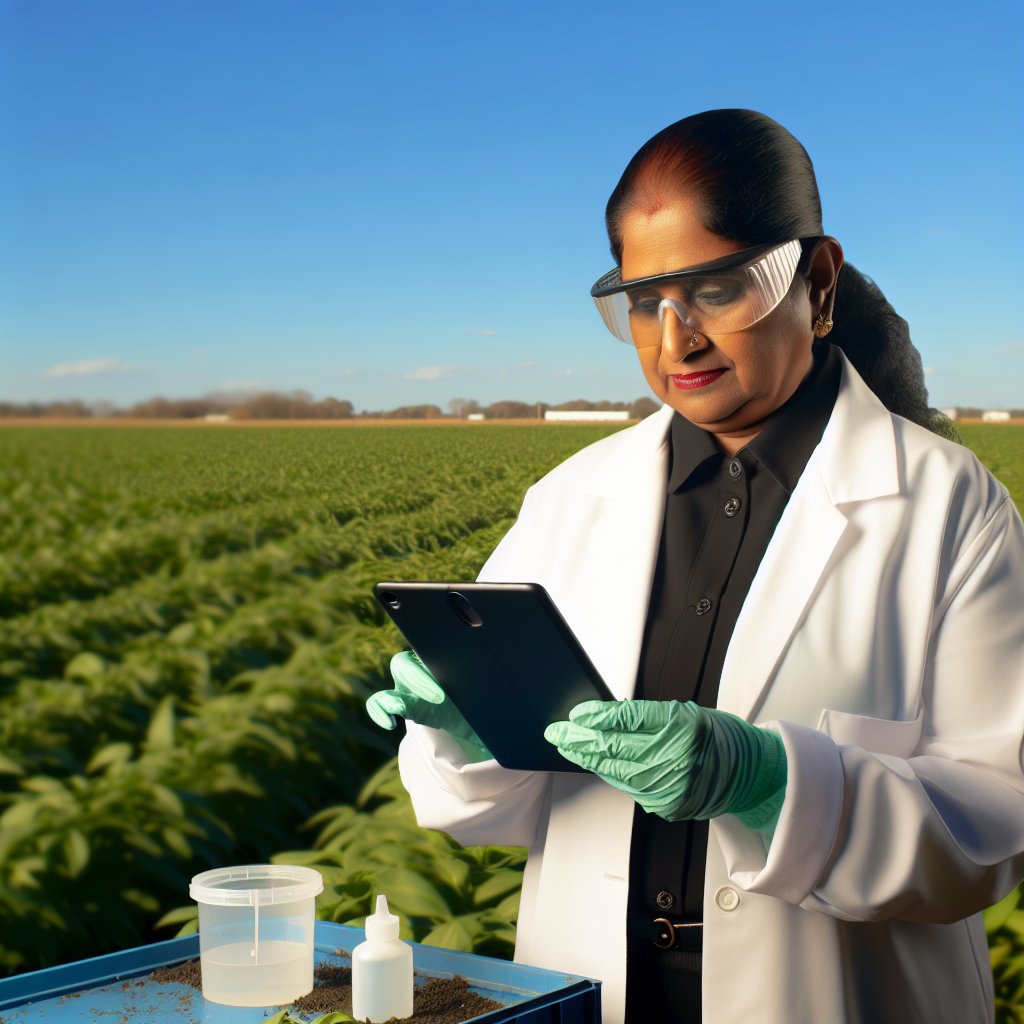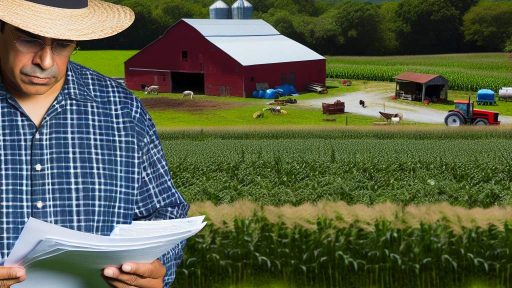Introduction to Pesticide Residues in Agriculture
Pesticide residues are a common concern in agricultural products.
Farmers often use pesticides to protect crops from pests and diseases.
However, these chemicals can remain on produce after harvesting.
The presence of pesticide residues raises health and safety issues.
Consumers demand food that is safe for consumption.
Yet, residues can often exceed acceptable safety levels.
This issue affects both domestic and international markets.
Moreover, it can impact exports if residues are too high.
Regulatory bodies work to establish safety limits for residues.
These regulations aim to protect consumers and the environment.
Understanding Pesticide Residue Regulations
Each country has its own set of regulations for pesticide use.
These regulations determine maximum residue limits (MRLs).
MRLs vary widely between different countries and crops.
Farmers must stay informed about these limits to comply.
Failure to comply can lead to sanctions and crop rejection.
Transform Your Agribusiness
Unlock your farm's potential with expert advice tailored to your needs. Get actionable steps that drive real results.
Get StartedHealth Implications of Pesticide Residues
Health risks arise from consuming food with pesticide residues.
Some pesticides are linked to serious health conditions.
Regulatory bodies assess and evaluate these health risks.
Consumers, therefore, prefer organic and pesticide-free options.
Reducing pesticides contributes to healthier food choices.
Consumer Awareness and Responsibility
Educating consumers on pesticide residues is crucial.
Safety guides can help individuals make informed choices.
Washing produce can reduce pesticide residues effectively.
Additionally, peeling fruits and vegetables offers more safety.
Buying local can further minimize exposure to harmful chemicals.
Advancements in Agricultural Practices
Innovative techniques help manage pesticide residues in agriculture.
Integrated Pest Management (IPM) is one such method.
IPM reduces reliance on chemical pesticides significantly.
Furthermore, precision agriculture employs technology to optimize usage.
This approach promotes efficient application and minimizes waste.
Ultimately, sustainable farming practices lead to safer produce.
Understanding Pesticide Residue Standards and Regulations
Defining Pesticide Residue
Pesticide residue refers to traces of pesticides found on agricultural products.
These residues occur due to the application of chemical substances for pest control.
Understanding these residues is critical for consumer safety and public health.
Regulatory Agencies and Their Roles
Regulatory agencies set the standards for pesticide residues globally.
The Environmental Protection Agency (EPA) governs pesticide use in the United States.
In the European Union, the European Food Safety Authority (EFSA) plays a similar role.
These agencies assess risks and define maximum residue limits (MRLs).
Maximum Residue Limits (MRLs)
MRLs indicate the maximum amount of pesticide residue allowed on foods.
Showcase Your Farming Business
Publish your professional farming services profile on our blog for a one-time fee of $200 and reach a dedicated audience of farmers and agribusiness owners.
Publish Your ProfileThese limits vary by crop type and pesticide used.
Compliance with MRLs ensures that agricultural products are safe for consumption.
Farmers must stay updated on these limits to avoid violations.
Importance of Compliance
Compliance with residue standards is essential for global trade.
Countries require that imported goods meet their specific MRLs.
Failing to comply can lead to product recalls and economic losses.
Furthermore, consumer trust hinges on the safety of food products.
Testing and Monitoring
Regular testing of agricultural products helps detect pesticide residues.
Government agencies conduct random and targeted testing regularly.
Private laboratories also provide testing services for producers.
Monitoring ensures that food products reach the market safely.
Consumer Awareness
Raising consumer awareness about pesticide residues is vital.
Education on safe practices can help consumers make informed choices.
Labeling and transparency regarding pesticide use play a key role.
Best Practices for Farmers
Farmers can adopt best practices to manage pesticide residues.
- Implement integrated pest management (IPM) techniques.
- Follow label instructions carefully when applying pesticides.
- Maintain accurate records of pesticide applications.
By following these practices, farmers can reduce pesticide residues effectively.
Common Types of Pesticides and Their Uses in Agriculture
Insecticides
Insecticides effectively control a variety of insect pests.
Farmers use them to protect crops from destructive species, such as aphids and caterpillars.
Many insecticides target specific pests, minimizing harm to beneficial insects.
They come in various forms, including sprays, granules, and baits.
Herbicides
Herbicides manage unwanted weeds in agricultural fields.
They help farmers maintain crop health by reducing competition for nutrients.
Many herbicides are selective, targeting only specific types of plants.
Farmers apply them before or after planting to manage weed populations effectively.
Fungicides
Fungicides protect crops from fungal diseases and infestations.
They are essential for maintaining crop quality and yield.
Farmers often apply fungicides at key growth stages to prevent disease outbreaks.
Different formulations allow for targeted application against various fungal species.
Rodenticides
Rodenticides control rodent populations that threaten crops and stored products.
Farmers use them to protect their harvest from damage caused by rodents.
Proper management practices are necessary to minimize risks to non-target species.
Effective rodenticides come in several forms, including bait blocks and powders.
Growth Regulators
Growth regulators influence plant growth and development.
Farmers utilize them to improve crop yield and quality.
These substances can enhance flowering, fruit set, and crop uniformity.
Proper timing of application is crucial for achieving desired effects.
Biopesticides
Biopesticides are derived from natural materials, such as plants and microorganisms.
They offer environmentally friendly alternatives to conventional pesticides.
Farmers increasingly adopt biopesticides to meet growing consumer demand for organic products.
Their use promotes biodiversity and reduces chemical exposure in agriculture.
Showcase Your Farming Business
Publish your professional farming services profile on our blog for a one-time fee of $200 and reach a dedicated audience of farmers and agribusiness owners.
Publish Your ProfileLearn More: Compliance Requirements For Agricultural Conservation Programs
Sources of Pesticide Contamination in Agricultural Products
Agricultural Practices
Agricultural practices play a critical role in pesticide contamination.
Farmers apply pesticides to control pests effectively.
However, improper application can lead to excessive residues.
Additionally, the timing of application affects residue levels.
Farmers must follow recommended guidelines to minimize risks.
Pesticide Drift
Pesticide drift occurs when chemicals move off-target during application.
This can happen due to wind or temperature inversions.
Nearby crops and non-target areas can suffer significant exposure.
To mitigate this issue, farmers should adopt buffer zones.
Water Contamination
Water sources can become contaminated with pesticides as well.
Runoff from fields often carries residues into nearby bodies of water.
This can affect aquatic life and contaminate drinking water supplies.
Implementing proper irrigation techniques can reduce this risk.
Soil Absorption
Pesticides can persist in soil for extended periods.
Sandy and clay soils exhibit different absorption rates.
The choice of pesticide affects how long it remains in the environment.
Understanding local soil composition is vital for effective management.
Market Supply Chains
Market supply chains also contribute to pesticide residues in food products.
Pesticides may be applied at various points in the supply chain.
Improper handling during transportation and storage can lead to contamination.
Consistent monitoring and regulation are essential to ensure safety.
Gain More Insights: Benefits of Farm-To-Table Policies: Enhancing Sustainability in Farming
Impact of Pesticide Residues on Human Health and the Environment
Understanding Pesticide Residues
Pesticide residues are chemicals left on food and in the environment after pesticide application.
These residues can enter the food chain through agricultural practices.
They may persist in soil and water, leading to long-term environmental effects.
Health Impacts on Humans
Pesticide residues can pose significant health risks to consumers.
Research links exposure to pesticide residues with various health issues.
These may include hormonal disruptions, neurological damage, and even cancer.
Vulnerable populations, such as children and pregnant women, are particularly at risk.
Studies indicate a correlation between pesticide exposure and developmental delays in children.
Environmental Consequences
Pesticide residues can adversely affect ecosystems and biodiversity.
They can contaminate water sources, harming aquatic life.
Additionally, pesticide runoff can lead to soil degradation and loss of soil fertility.
Wildlife is not immune, as many species are sensitive to these chemical compounds.
Insect populations, crucial for pollination, have also seen declines due to pesticide exposure.
Regulatory Measures
Governments impose regulations to limit pesticide residue levels in food products.
These measures help ensure food safety for consumers.
Organizations like the EPA set maximum limits for different pesticides.
Compliance with these regulations varies by region and crop type.
Showcase Your Farming Business
Publish your professional farming services profile on our blog for a one-time fee of $200 and reach a dedicated audience of farmers and agribusiness owners.
Publish Your ProfileConsumer Awareness and Practices
Consumers can play a crucial role in managing pesticide residue risks.
Choosing organic products can significantly reduce exposure to harmful chemicals.
Washing fruits and vegetables thoroughly can help remove some pesticide residues.
Additionally, being informed about local agriculture practices can guide purchasing decisions.
Learn More: Steps to Apply for Agricultural Insurance Coverage
Best Practices for Reducing Pesticide Residues in Crop Production
Choosing the Right Pesticides
Select pesticides that are effective but have lower toxicity to humans and wildlife.
Understanding the active ingredients helps farmers make informed choices.
Additionally, using biopesticides can be a safer option for pest management.
Implementing Integrated Pest Management
Integrated pest management (IPM) emphasizes prevention and monitoring.
Farmers can use a combination of biological, cultural, and chemical tactics.
Regular scouting for pests helps in timely decision-making.
Optimizing Application Techniques
Proper application techniques reduce pesticide drift and runoff.
Using equipment calibrated for precision ensures accurate pesticide delivery.
Moreover, applying pesticides during calm weather minimizes off-target distribution.
Timing of Applications
Timely application of pesticides can significantly lower residue levels.
Understanding pest life cycles helps in determining the best times for treatment.
Applying pesticides at night may also help reduce exposure to beneficial insects.
Crop Rotation and Diversification
Implementing crop rotation can disrupt pest cycles effectively.
Diversifying crops also leads to a healthier ecosystem, reducing reliance on chemicals.
This approach fosters natural pest control through beneficial insect attraction.
Maintaining Soil Health
Healthy soil promotes robust plant growth, making crops less susceptible to pests.
Utilizing cover crops can enhance soil structure and fertility.
This practice encourages a thriving microbial community that supports plant health.
Regular Monitoring and Testing
Conducting regular soil and plant tissue tests helps identify pesticide residues.
This data enables farmers to take appropriate action based on residue levels.
Implementing a monitoring program fosters continual improvement in practices.
Gain More Insights: Water Conservation Strategies In Agricultural Policies

Testing and Monitoring Methods for Pesticide Residues
Importance of Testing
Testing for pesticide residues is crucial for food safety.
It helps ensure that agricultural products meet regulatory standards.
Moreover, it protects consumer health and confidence.
Types of Testing Methods
Various methods exist for detecting pesticide residues.
Chromatography techniques are among the most widely used.
Additionally, mass spectrometry provides precise measurements.
Enzyme-linked immunosorbent assay (ELISA) offers a simpler alternative.
Gas Chromatography
Gas chromatography separates compounds in a sample.
This technique is effective for volatile pesticides.
It provides accurate, reliable results quickly.
Liquid Chromatography
Liquid chromatography works well for non-volatile compounds.
This method allows for more complex sample analysis.
It is particularly useful for diverse pesticide families.
Showcase Your Farming Business
Publish your professional farming services profile on our blog for a one-time fee of $200 and reach a dedicated audience of farmers and agribusiness owners.
Publish Your ProfileMass Spectrometry
Mass spectrometry identifies and quantifies chemical substances.
It offers high sensitivity and specificity for residue detection.
Combining it with chromatography enhances analysis capabilities.
Monitoring Techniques
Continuous monitoring of agricultural products is essential.
Regular sampling helps track pesticide levels over time.
Furthermore, it enables swift action when residue levels exceed limits.
Field Sampling
Field sampling involves collecting representative samples from crops.
This method helps assess pesticide levels accurately in real-time.
Testing Laboratories
Accredited labs perform rigorous testing on collected samples.
They utilize advanced techniques to ensure reliability.
Lab results provide valuable data for stakeholders involved in production.
Regulatory Compliance
Regulatory frameworks dictate acceptable pesticide levels.
Farmers and distributors must comply with these regulations.
Keeping records of testing ensures accountability and transparency.
Emerging Technologies
Innovations are enhancing residue detection methods.
For instance, rapid testing kits are becoming popular.
These kits enable on-site testing with quick results.
Additionally, blockchain technology improves traceability in the supply chain.
The Role of Integrated Pest Management (IPM) in Mitigating Residues
Understanding Integrated Pest Management
Integrated Pest Management, or IPM, is a sustainable approach to pest control.
This method combines various management strategies for effective outcomes.
Farmers use IPM to reduce reliance on chemical pesticides.
Consequently, this approach helps minimize pesticide residues in crops.
Strategies Within Integrated Pest Management
IPM employs multiple strategies tailored to specific pests and conditions.
These strategies include biological control, cultural practices, and monitoring.
Biological control uses natural enemies to suppress pest populations.
Cultural practices involve changing agricultural practices to prevent pest infestations.
Monitoring allows farmers to make informed decisions based on pest activity.
Benefits of Adopting IPM Practices
Adopting IPM practices leads to lower pesticide residues in agricultural products.
This process promotes environmental and human health through reduced exposure.
Employing IPM enhances farm biodiversity by fostering a balanced ecosystem.
Moreover, it can improve the economic viability of farming operations.
Implementing IPM on Farms
Farmers can implement IPM by assessing their pest problems comprehensively.
This initial assessment helps in understanding pest dynamics in their fields.
Next, they can develop an IPM plan based on the assessment findings.
Continuous education is crucial for farmers to stay updated with IPM methods.
Case Studies of Successful IPM Practices
Several farms have successfully implemented IPM to manage pest problems.
For example, Green Valley Farms reduced pesticide use by 30% using IPM.
Additionally, Sunny Acres implemented crop rotation, enhancing pest control naturally.
These case studies demonstrate the effectiveness of IPM in real-world scenarios.
Future Trends in Pesticide Regulation and Management Strategies
Evolving Regulatory Frameworks
Regulatory frameworks for pesticides are shifting towards more stringent guidelines.
Showcase Your Farming Business
Publish your professional farming services profile on our blog for a one-time fee of $200 and reach a dedicated audience of farmers and agribusiness owners.
Publish Your ProfileGovernments are investing in research to assess long-term impacts.
Additionally, collaboration among international bodies is increasing.
Such efforts aim to align regulations worldwide for better consistency.
Technological Advancements in Monitoring
Technology plays a crucial role in monitoring pesticide residues.
Drone technology offers real-time data collection in the field.
This innovation significantly reduces the time spent on sampling.
Moreover, AI systems are improving data analysis and decision-making.
Integrated Pest Management Approaches
Integrated pest management (IPM) combines various strategies for pest control.
Farmers are adopting IPM to minimize reliance on chemical pesticides.
This method includes biological control and habitat manipulation.
Consequently, it promotes a more sustainable agricultural model.
Consumer Awareness and Demand for Transparency
Consumer awareness regarding pesticide residues is rising.
Shoppers increasingly favor organic and minimally processed products.
Consequently, producers are focusing on transparency in their practices.
This trend leads to better labeling and safety information for consumers.
Collaboration Between Stakeholders
Collaboration among farmers, researchers, and government bodies is essential.
Such partnerships enhance the sharing of best practices and innovations.
Moreover, joint initiatives can lead to more effective pesticide management.
This coordinated effort directly benefits public health and the environment.
Additional Resources
Regulation of Biotech Plants | Home




